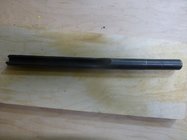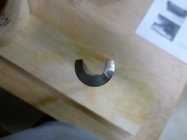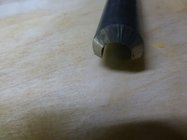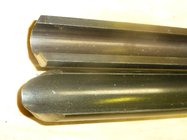I recently bought a big 3/4" bottom feeder bowl gouge (bare bar with no handle or bolster) from Ashley Harwood. I installed it on a 22" Hosaluk handle with the adapter and WOW... out of the box without any honing, it really turns the inside corner of a shallow and deep bowl nicely. No tool marks in my bowls now and a sweet looking bottom surface that doesn't need sanding. Yes it was expensive but I'm very impressed with it. It's one of my favorite lathe tools now.Does anybody have a photo to share of what is called a "Bottom Bowl Gouge"? Doug Thompson has one listed on his website, but no photo. He described it to me on the phone, but for me, a picture is worth more than words. Thompson said it is ground like a spindle roughing gouge, and that Ashley Harwood and Stuart Batty are fond of them, but I can't picture it.
-
November 2025 Turning Challenge: Wall Hanging! (click here for details) -
Congratulations to Craig Morton, People's Choice in the October 2025 Turning Challenge (click here for details) -
Congratulations to Andy Chen for "Mesquite Vase with Polymer Clay Millefiori" being selected as Turning of the Week for November 3, 2025 (click here for details) -
Welcome new registering member. Your username must be your real First and Last name (for example: John Doe). "Screen names" and "handles" are not allowed and your registration will be deleted if you don't use your real name. Also, do not use all caps nor all lower case.
You are using an out of date browser. It may not display this or other websites correctly.
You should upgrade or use an alternative browser.
You should upgrade or use an alternative browser.
Bottom Bowl Gouge?
- Thread starter Tom Albrecht
- Start date
Odie
Panning for Montana gold, with Betsy, the mule!
A few will remember Del Stubs and his dvd where he was cutting wood with a modified piece of water pipe. It comes down to presenting the tool in a position that it will cut cleaning and adjusting your movement in unison with the particular tool. Find what works for you and practice to perfect that cutting from top to to bottom of the bowl. Turning fifty years and still leaning.
That reminds me about learning to do the "twist", and we're not talking about dancing along with Chubby Checker here! This is a way of rotating the gouge on it's longitudinal axis while the cut is executed at a point on the wing, but proceeds along the full length of the wing. This, while negotiating a transitional curve....
-----odie-----
- Joined
- Jan 27, 2005
- Messages
- 13,169
- Likes
- 5,737
- Location
- Dalworthington Gardens, TX
- Website
- pbase.com
That reminds me about learning to do the "twist", and we're not talking about dancing along with Chubby Checker here! This is a way of rotating the gouge on it's longitudinal axis while the cut is executed at a point on the wing, but proceeds along the full length of the wing. This, while negotiating a transitional curve....
-----odie-----
In his video, Del Stubbs said, "You paid for the whole edge so you ought to use the whole edge". Just for fun while turning the exterior I sometimes do as odie says and go from a push cut to a pull cut or vice versa while gradually rotating the tool in a continuous fluid motion. Just an extra "twist" to the "dance" (not the same dance as chasing a dancing lathe around the shop ... I feel like the turner should always lead).
That friend is likely Tom Wirsing, studio platter turner extraordinaire! His platters are absolutely breathtaking. Oh, and he was AAW pres for a time. He wrote an article for American Woodturner a while back about metallurgy - it’s right there in the archives to review. His history is very self-taught as he clearly shares during his demos and why he uses 10v tools - particularly his copious scrapers of varying profiles. I am fortunate to have a private recording of a 2021 club demo and he mentions his “history in metallurgy” and I believe, as I can, that his views are quite biased to his context. No, not gonna share the demo as permissions were only for limited club documentation use. We have two metallurgist PhD’s in our club who really made some excellent points with Tom in discussion - they are very hands on in the field and pioneers. Despite being a physicist, his lack of metallurgy hands-on experience and only limited home study showed that his “dislike” of M42 was, again in my view, quite Swiss cheesey. I’m grateful that he did not slam or attack M42 tool manufacturers or very successful turners who use those M42 tools far more and much more rigorously than him. Remember, that while Woodturners who sell tools are Woodturners, they aren’t making their nest egg off of demos and magazine articles - they need to sell tools with good margins. We, the consumer, are often the suckers when it comes to new tools. Ask 10 Woodturners what steel is best and you’ll get no less than 15 answers. Each tool steel has its pros and cons. For me picking a camp is as multifaceted as that gouge photo.I asked Ashley if she meant Stuart - when talking about the M42 vs V10...she replied, "No, this person has a history in metallurgy". So, I don't know who it is and she did not divulge any names.
- Joined
- Jan 27, 2005
- Messages
- 13,169
- Likes
- 5,737
- Location
- Dalworthington Gardens, TX
- Website
- pbase.com
For me picking a camp is as multifaceted as that gouge photo.
I took a closer look at the photo ... I think it might have more facets than the Hope diamond.
Bill, Can you tell how the bottom of the bowl Thompson differs from his regular U flute gouges, if it does?
Dean it is late today I'll run down to the shop tomorrow and see what I can show you.
Thanks. The BOB gouge almost looks like a spindle roughing gouge with those thick sides. Beefy.Dean here is a Photo of the 3/4" BOTB AND A 3/4" U Gouge. The bottom is a tighter U with thick sides and the U is a wider U going to sharp sides. They are not interchangeable.
John has the best videos about Hunter tools, and lots more. I always recommend him when someone wants to know how to use the Hunter ToolsI cant link from my phone but if you type in john60lucas/Hunter. It will take you right to the Badger video.
I am trying to be resourceful, and if you were looking to start with two of these cutters what would you suggest?The flat carbide tools are nothing like the cupped carbide Hunter tools. The Hunter tools can be used as bevel riding tools and leave a spectacular finish. Here is a quick piece I cut with the Hunter badger to show how clean it cuts and to demonstrate how you can cut a 90° corner on a box.
View attachment 43304
I meant to add thank you.I am trying to be resourceful, and if you were looking to start with two of these cutters what would you suggest?
john lucas
AAW Forum Expert
The two Hunter cutters I use the most are the Badger and the Viceroy. The Badger is for finishing box interiors and bowl bottoms. I use the the Viceroy for hollowing my smaller open pieces and for knocking off the corners of really out of round pieces.
- Joined
- Feb 6, 2010
- Messages
- 3,421
- Likes
- 2,503
- Location
- Brandon, MS
- Website
- threeringswoodshop.square.site
I might add to what John said that the Viceroy is great for hollowforms up to about 5 or 6 inches.I am trying to be resourceful, and if you were looking to start with two of these cutters what would you suggest?
The great thing about the Hunter carbide tools is that they cut/slice the wood. They are not scrapers. Mike Hunter has developed such a great range of tools that I can't think of a case were they can't be used. They are not replacements for my Thompson tools they are a compliment to my turning armory and I would be at a loss without my Hunter carbides.




